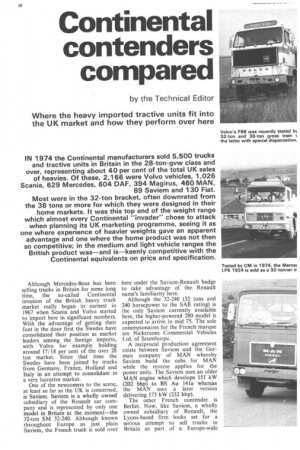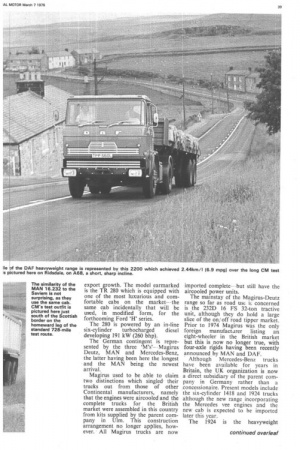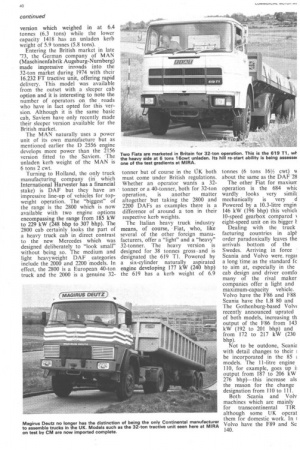Continental contenders compared
Page 40

Page 41

Page 42

If you've noticed an error in this article please click here to report it so we can fix it.
by the Technical Editor Where the heavy imported tractive units fit into the UK market and how they perform over here
IN 1974 the Continental manufacturers sold 5,500 trucks and tractive units in Britain in the 28-ton-gvw class and over, representing about 40 per cent of the total UK sales of heavies. Of these, 2,166 were Volvo vehicles, 1,026 Scania, 629 Mercedes, 604 DAF, 394 Magirus, 460 MAN, 89 Saviem and 130 Fiat. Most were in the 32-ton bracket, often downrated from the 38 tons or more for which they were designed in their home markets. It was this top end of the weight range which almost every Continental "invader" chose to attack when planning its UK marketing programme, seeing it as one where experience of heavier weights gave an apparent advantage and one where the home product was not then so competitive; in the medium and light vehicle ranges the British product was—and is—keenly competitive with the Continental equivalents on price and specification.
Although Mercedes-Benz has been selling trucks in Britain for some long time, the so-called Continental invasion of the British heavy truck market really began in earnest in 1967 when Scania and Volvo started to import here in significant numbers. With the advantage of getting their foot in the door first the Swedes have consolidated their position as market leaders among the foreign imports, with Volvo for example holding around 17/18 per cent of the over 28 ton market. Since that time the Swedes have been joined by trucks from Germany, France, Holland and Italy in an attempt to consolidate in a very lucrative market.
One of the newcomers to the scene, at least so far as the UK is concerned, is Saviem. Saviem is a wholly owned subsidiary of the Renault car company and is represented by only one model in Britain at the moment—the 32-ton SM 32-240. Although known throughout Europe as just plain Saviem, the French truck is sold over here under the Saviem-Renault badge to take advantage of the Renault name's familiarity here.
Although the 32-240 (32 tons and 240 horsepower to the SAE rating) is the only Saviem currently available here, the higher-powered 280 model is expected to arrive in mid 75. The sole concessionaires for the French marque are Nickersons Commercial Vehicles Ltd, of Scunthorpe.
A reciprocal production agreement exists between Saviem and the German company of MAN whereby Saviem build the cabs for MAN while the reverse applies for the power units. The Saviem uses an older MAN engine which develops 151 kW (202 bhp) to BS Au 141a whereas the MAN uses a later version delivering 173 kW (232 bhp).
The other French contender is Berliet. Now, like Saviem, a wholly owned subsidiary of Renault, the Lyons-based firm looks set for a serious attempt to sell trucks in Britain as part of a Europe-wide export growth. The model earmarked is the TR 280 which is equipped with one of the most luxurious and comfortable cabs on the market--the same cab incidentally that will be used, in modified form, for the forthcoming Ford 'H' series.
The 280 is powered by an in-line six-cylinder turbocharged diesel developing 191 kW (260 bhp).
The German contingent is represented by the three 'M's'--Magirus Deutz, MAN and Mercedes-Benz, the latter having been here the longest and the MAN being the newest arrival.
Magirus used to be able to claim two distinctions which singled their trucks out from those of other Continental manufacturers, namely that the engines were aircooled and the complete trucks for the British market were assembled in this country from kits supplied by the parent company in Ulm. This construction arrangement no longer applies, however. All Magirus trucks are now imported complete—but still have the aircooled power units. The mainstay of the Magirus-Deutz range so far as road use i concerned is the 232D 16 FS 32-ton tractive unit, although they do hold a large slice of the on! off road tipper market. Prior to 1974 Magirus was the only foreign manufacturer listing an eight-wheeler in the British market but this is now no longer true, with four-axle rigids having been recently announced by MAN and DAF, Although Mercedes-Benz trucks have been available for years in Britain, the UK organization is now a direct subsidiary of the parent company in Germany rather than a concessionaire. Present models include the six-cylinder 1418 and 1924 trucks although the new range incorporating the Mercedes vee engines and the new cab is expected to be imported later this year.
The 1924 is the heavyweight version which weighed in at 6.4 tonnes (6.3 tons) while the lower capacity 1418 has an unladen kerb weight of 5.9 tonnes (5.8 tons).
Entering the British market in late '73, the German company of MAN (Maschinenfabrik Augsburg-Nurnberg) made impressive inroads into the 32-ton market during 1974 with their 16.232 FT tractive unit, offering rapid delivery. This model was available from the outset with a sleeper cab option and it is interesting to note the number of operators on the roads who have in fact opted for this version. Although it is the same basic cab, Saviem have only recently made their sleeper version available for the British market.
The MAN naturally uses a power unit of its own manufacture but as mentioned earlier the D 2556 engine develops more power than the 2156 version fitted to the Saviem. The unladen kerb weight of the MAN is 6 tons 2 cwt.
Turning to Holland, the only truck manufacturing company (in which International Harvester has a financial stake) is DAF but they have an impressive line-up of vehicles for topweight operation. The "biggest" of the range is the 2800 which is now available with two engine options encompassing the range from 185 kW to 229 kW (248 bhp to 307 bhp). The 2800 cab certainly looks the part of a heavy truck cab in direct contrast to the new Mercedes which was designed deliberately to "look small" without being so. The medium and light heavyweight DAF categories include the 2000 and 2200 'models. In effect, the 2800 is a European 40-ton truck and the 2000 is a genuine 32 tonner but of course in the OK both must come under British regulations.
Whether an operator wants a 32 tonner or a 40-tonner, both for 32-ton operation, is another matter altogether but taking the 2800 and 2200 DAFs as examples there is a difference of around a ton in their respective kerb weights.
The Italian heavy truck industry means, of course, Fiat, who, like several of the other foreign manufacturers, offer a "light" and a "heavy" 32-tonner. The heavy version is designed for 38 tonnes gross and is designated the 619 TI. Powered by a six-cylinder naturally aspirated engine developing 177 kW (240 bhp) the 619 has a kerb weight of 6.9 tonnes (6 tons 16V2 cwt) about the same as the DAF 28 The other Fiat for maxiurr operation is the 684 whic wardly looks very simili mechanically is very d Powered by a 10.3-litre engin 146 kW (196 bhp) this vehich 10-speed gearbox compared eight-speed unit on its bigger t Dealing with the truck facturing countries in alpt order paradoxically leaves the arrivals bottom of the Swedes. Arriving in force Scania and Volvo were. regal a long time as the standard fc to aim at, especially in the cab design and driver comfo many of the rival maker. companies offer a light and maximum-capacity vehicle. Volvo have the F86 and F88 Seania have the LB 80 and The Gothenburg-based Volv( recently announced uprated of both models, increasing th output of the F86 from 143 kW (192 to 201 bhp) and from 172 to 217 kW (230 bhp), Not to be outdone, Scania with detail changes to their I be incorporated in the 85 models. The 11-litre engine 110, for example, goes up ii output from 187 to 206 kW 276 bhp)--this increase als the reason for the change designation from 110 to Ill. Both Scania and Volv machines which are mainly for transcontinental TIR although some UK operat them for domestic work. In Volvo have the F89 and Sc 140.












































































































































































